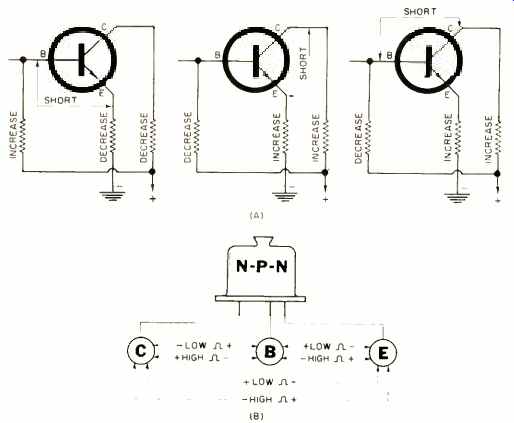(source: Electronics World, Aug. 1964)
By GLEN McKINNEY
SINCE operation of a transistor depends largely on the current flowing through its associated resistors, they can be used as convenient test points for determining the transistor's condition.
Fig. 1A shows the probable change in voltage across these resistors when the transistor shorts in any of the three possible ways. This information is useful in locating a shorted transistor as the circuit resistors will indicate either an increase or decrease in voltage drop depending on which two electrodes of the transistor have become shorted. When there is an abnormal drop, either high or low, across these resistors (and the resistors test good ) chances are that the transistor is defective. A little experience in this voltage measuring technique will yield fruitful results in pin-pointing “leaky" or shorted units.
Fig. 1B is helpful for checking and comparing transistors that are out of the circuit. This shows the approximate resistance to expect when measuring between the different electrodes, for both forward and reverse directions.

Fig. (A) shows how voltage at transistor terminals varies with different
elements shorted. (B) shows approximate values of resistance measured
between various transistor elements.
There should be a large difference between the resistance measured as the ohmmeter leads are reversed if the transistor is good. In one direction, the resistance will be very low. In the other direction, it should read fairly high (200,000 ohms or so) . The exact resistance measured will vary for different types of transistors, but there will always be a high-to-low resistance ratio when the ohmmeter leads are reversed. This method of checking works with either n-p-n or p-n-p transistors, however, the polarities shown will be reversed for the high-low readings with the p-n-p type. A word of caution is in order here as to the ohmmeter range to use when making these resistance measurements. The lower scales of some ohmmeters can supply damaging currents to the transistor under test, while the higher scales can supply damaging potentials.
As a precautionary measure, it is best to start out on the highest, safe range (depending on the ohmmeter) then change to the scale that gives an adequate reading.